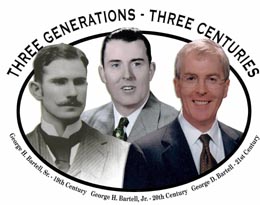From small beginnings as a single drug store on Seattle's Jackson Street in 1890, Bartell Drugs has grown to 58 stores serving the Puget Sound region in 2011. Its longevity has earned the company the distinction of being the oldest drug store chain in the United States. This slideshow presents the rich history of the Bartell Drug Company, and was written and curated by Phil Dougherty.
Bartell Drugs: A Slideshow
- Posted 10/27/2011
- HistoryLink.org Essay 9921
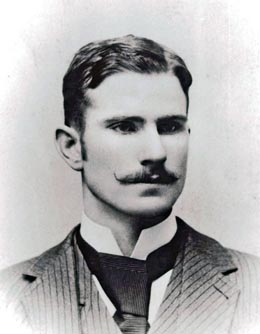
George Bartell opened his first drug store in 1890 in Seattle, and by the 1920s had grown his business from a fledgling enterprise to a thriving chain of pharmacies scattered throughout the city.
Today the Bartell Drug Company has 58 stores throughout the Puget Sound region. Throughout its long history, it has remained in the Bartell family.

Bartell was born in 1868 in Dickinson County, Kansas, and grew up on his family's farm in Junction City. When he was 14 he went to Lincoln, Kansas, and found a job at a local drug store. He flourished there, and by the time he was 17 was the assistant manager of the store. He became a licensed pharmacist when he was 18.

But like many in the late nineteenth century, Bartell was lured by the call of the West. In 1887 he moved to Seattle, and after working a series of odd jobs started part-time work at the Lake Washington Pharmacy at 2911 Jackson Street in March 1890.
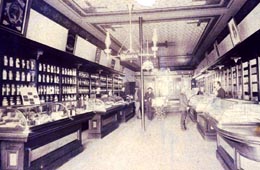
Drug stores in the 1890s were considerably more primitive than they are today or, for that matter, than what they would be just a few decades later. In his 15-by-30-foot store Bartell sold crude drugs extracted from plants like bloodroot, belladonna, and foxglove, as well as bark from cascara and cinchona trees. He also sold oils and medicinal chemicals such as calomel, sulfur, and ipecac.
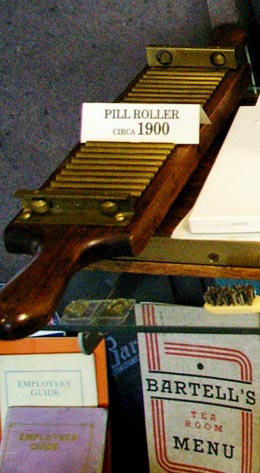
Bartell handmade various medications into pills and powders, and folded some of the more unpleasant-tasting medicines in onion skins to try to hide the taste. When capsules later came into use, he had to warn his customers not to open them before taking them.

Bartell lived in the back of the store building, and worked 12-hour days -- sometimes longer -- seven days a week. He was essentially on call to fill prescriptions whenever he was needed. His prescription blanks read "Prescriptions Carefully Compounded At All Hours."
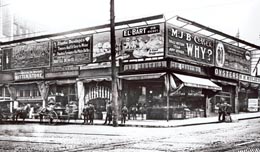
In 1897 Bartell joined the Klondike Gold Rush to the Yukon and did relatively well in his adventures there. But after a year he returned to Seattle with a plan to open several drug stores downtown. He opened his first new store late in 1898 at 506 2nd Avenue, and named it "Bartell's Owl Drug Store." The "owl" represented the all-night hours the store stayed open.
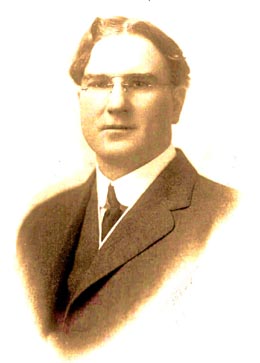
Bartell soon saw that he could sell his merchandise at a lower price than what was charged by his downtown competitors, but they responded quickly and formed "The Seattle Drug Trust" to fight him. To add insult to injury, the only wholesaler in town then refused to sell drugs to Bartell.
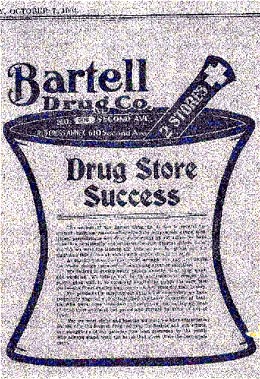
Bartell responded by buying his merchandise elsewhere. He also ran ads in the Seattle papers telling the public of the trust and demonstrating that his prices were lower than those of his competitors. His strategy worked. The trust went bust, and his business jumped.
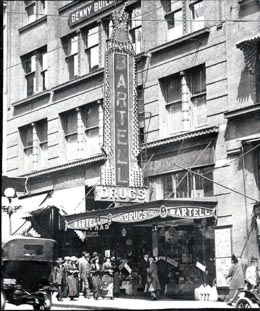
Bartell Drugs continued to slowly expand over the next few years, adding two new locations in 1904 and 1908, and three more in the early 1910s.
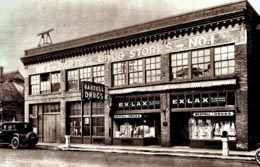
In 1914 Bartell established Bartell Drugs' headquarters at 1906 Boren Avenue in Seattle. In 1928 the company opened a new building next door, at 1916 Boren, and moved its offices there. Bartell's headquarters remained at 1916 Boren until 1985.

About 1913 Bartell opened a candy factory in the building at 1906 Boren. It became well-known for its Bartell Peanut Brittle and hand-dipped chocolate cherries.
By 1930 Bartell Drugs was selling a ton of candy daily. Even so, the company closed the factory about 1938.

And in 1917 Bartell Drugs opened a photo laboratory at 1906 Boren Avenue, which soon was capable of developing and returning prints to Bartell's various store locations within five hours by motorcycle courier -- a real feat in those days.
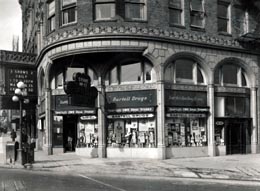
From its earliest years the company numbered all of its stores, such as "Drug Store No. 8" at the store's Pioneer Square location, and "Store No. 12" at the store's location on Stewart Street in Seattle.
Today Bartell Drugs continues this tradition of numbering its stores, though the numbers are no longer displayed on its signs.

The 1920s were boom years for the company. Ten new locations opened during the decade, and by the end of 1929 Bartell Drugs had 15 stores operating in Seattle.
The stores also began offering a broader array of merchandise, such as clocks, cameras, and exercise equipment.
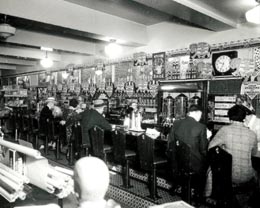
All of the Bartell stores added in the 1920s had soda fountains. Soda fountains weren't new in the 1920s -- Bartell's Owl Drug Store had installed one of the first ones in Seattle about 1902 -- but by the Roaring Twenties they had become immensely popular.
Soda fountains provided a social outlet that had been eliminated when saloons closed after Prohibition took effect in Washington state in 1916.

The company was financially secure enough to withstand the Great Depression of the 1930s, particularly since it sold many essentials that people needed despite the Depression's severity. In fact, during the first half of the decade, the company added five new locations. George Bartell had hit his stride.
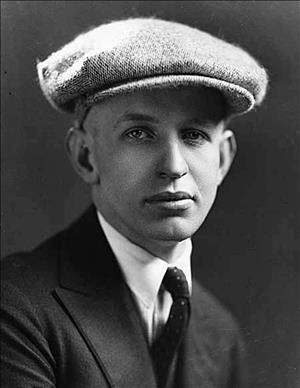
Leo Lassen, a Seattle Star reporter who went on to become a legendary baseball radio announcer in the Emerald City, described Bartell in his prime in a 1930 article for the Star:
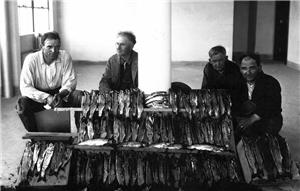
"He speaks rather hurriedly and is a ready conversationalist. He loves outdoor life and prefers the company of young people. Bartell has just returned from a week's fishing in the Cascades; he likes to pack into trackless streams. There is nothing fussy as an executive about Bartell. He had his fishing paraphernalia packed in his private office and spent half an hour demonstrating its various uses."
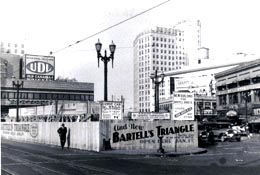
In 1935 Bartell leased a site at 401 Pine Street in downtown Seattle for another new store, which was built later that year. The two-story, fireproof building had a marble exterior and non-rusting metal trim, and a distinctive triangular shape which soon earned it the name "the triangle store."

Over the next half century this store would be known as Bartell Drugs's flagship store. A tea room was on its top floor, and merchandise was sold on the first floor and in the basement. The store was closed in 1984 and the building demolished as part of construction of the Westlake project.
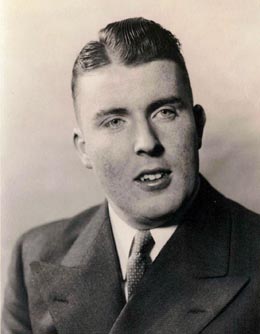
In 1935 George Bartell Jr. joined Bartell Drugs as a warehouseman. Four years later he became president of the company, though the senior Bartell remained a presence until his passing in 1956.
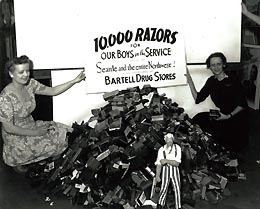
In 1941 America entered World War II. The war and resulting social changes had a big impact on Bartell's operations. Though Bartell Drugs had always been progressive in hiring women -- George Bartell hired one of the first women pharmacists in Seattle early in the twentieth century -- the company hired more women during the war as the result of the manpower shortage.
Some of these women stayed on after the war.
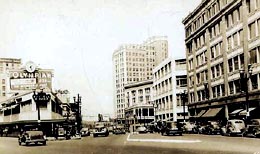
But it was additional social changes that came after the war, as well as a law known informally as the "fair trade law," that had a more profound effect on the company as it moved toward the 1950s.
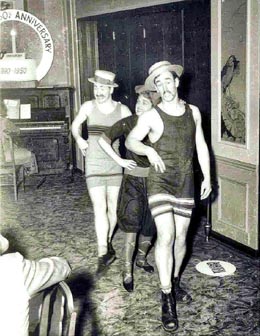
The decade got off to an auspicious start for Bartell Drugs. In the spring of 1950 it celebrated its 60th anniversary, and the following spring Bartell's opened a store in the Northgate Shopping Mall in Seattle, the country's first regional shopping center to be defined as a "mall." The stores faced "a wide shopping walkway, probably to be known as the Mall or Plaza, in which no vehicles will be permitted" (The Seattle Times).
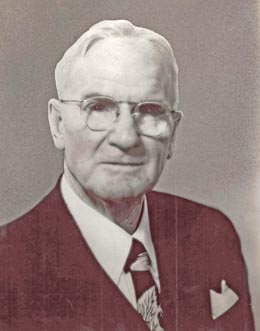
When George Bartell Sr. passed away in 1956, Bartell Drugs had 23 stores operating in the greater Seattle area, and the company also did a brisk mail order business, receiving orders from as far away as Sweden, Turkey, and India.
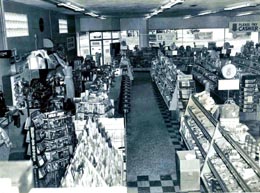
But by this time various issues the company faced were intensifying. Trade laws prevented it from lowering prices on certain merchandise to meet competition from other retailers who flouted these laws. Other issues included limited parking at many of Bartell's downtown locations and a drop in Bartell's soda fountain business. Also, the rise of self-service drug stores began to threaten Bartell Drugs' traditional full-service operation.

During the late 1950s and early 1960s the company closed nearly half its stores, including six locations in 1961. By the end of 1961 Bartell Drugs had only 12 locations still in operation.

In the midst of these woes, the Seattle World's Fair arrived in 1962. The southern terminus of the newly built monorail was next to Bartell's triangle store downtown, which gave the store a big -- and exciting -- boost in business during the fair.

Bartell Drugs had always believed in promoting from within the company. But in order to meet the challenges that the company faced in the early 1960s, George Bartell Jr. retained an independent firm to evaluate the issues and make recommendations for changes.
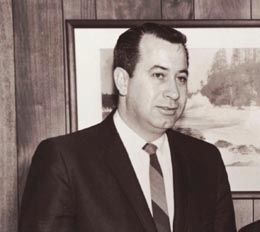
But the company's problems continued. After several management changes, Bartell Drugs eventually released the outside consultants and once again began promoting from within.
In 1965 the company promoted Bellevue store manager Val Storrs to Operations Manager and Ballard store manager Gordon O'Reilly to Merchandise Manager.
Storrs and O'Reilly understood what was needed to move the company forward and gradually made the personnel and merchandise changes necessary to adapt.
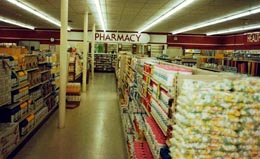
Bartell Drugs made further changes during the 1970s. The soda fountains and large, elaborate window displays disappeared. The interior layout of the stores, with their well-lit, wide aisles and lower shelves to provide merchandise within easy reach of the customer, began to resemble the Bartell stores that we know today.
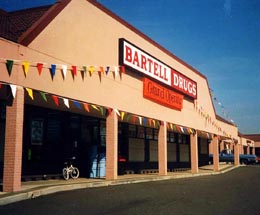
By the late 1970s Bartell Drugs was adding new stores at an increasing pace, and during the 1980s this growth accelerated, particularly in Seattle's suburbs. Bartell Drugs opened five new stores in a single day on September 7, 1984, as the result of its purchase of the U.S. operations of Shoppers Drug Mart, a Canadian drug store chain. The company closed the 1980s with 31 stores in operation, an increase of 14 stores during the decade.

Nineteen ninety was a big year for the Bartell Drug Company. On April 1, 1990, George Bartell Jr. stepped down as president (though, like his father before him, he remained a presence in the company for many years after). He was succeeded by his son, George D. Bartell.
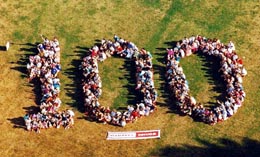
Bartell Drugs also celebrated its centennial in 1990. It was a year-long celebration, complete with birthday cakes served from time to time at its stores during the year and, in August, a drawing at each of the stores for an 1890 silver dollar.
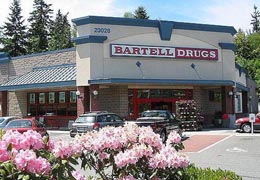
The rapid growth and expansion that the company enjoyed in the 1980s continued through the 1990s and into the twenty-first century. In 2011, Bartell Drugs has 58 locations in operation with nearly 1,700 full and part-time employees.

Bartell Drugs has also received significant community recognition for its work. For example, in 2006 the company was awarded the 13th Annual Best in the Northwest Washington Family Business Award in the Large Business category by the Family Enterprise Institute of the Pacific Lutheran University School of Business.
Licensing: This essay is licensed under a Creative Commons license that encourages reproduction with attribution. Credit should be given to both HistoryLink.org and to the author, and sources must be included with any reproduction. Click the icon for more info. Please note that this Creative Commons license applies to text only, and not to images. For more information regarding individual photos or images, please contact the source noted in the image credit.

